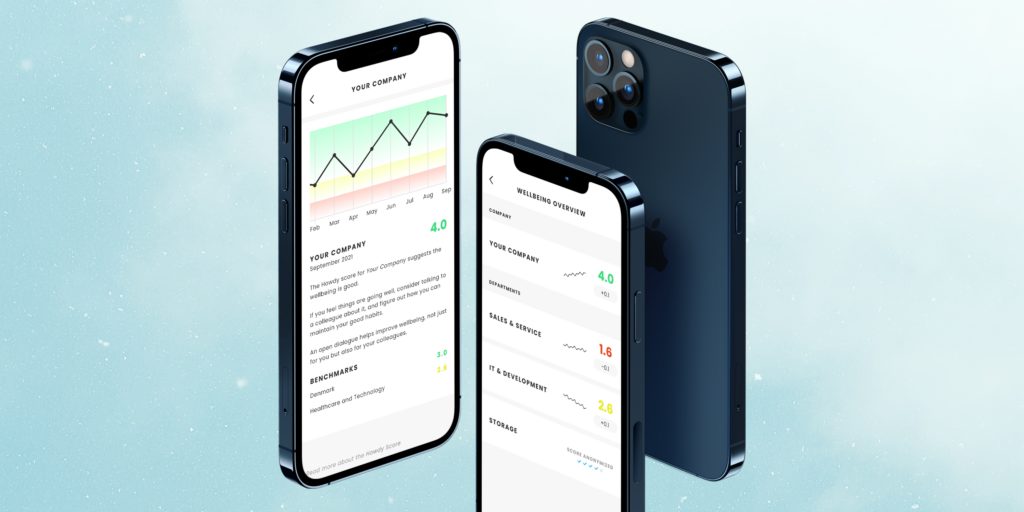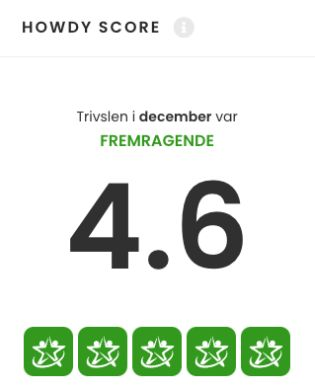A good working climate is a key term at any place of work. A high degree of employee wellbeing is a strong basis for success both for the employees, the management, and on the bottom line. Therefore, it is important, that leaders and managers have insight into how the employees are doing, and that the managers know how they can seek to create better circumstances for the working environment. A tool that can be used to map out the employees’ wellbeing is Howdy – that is, if you as the employer know how to take advantage of the tool’s full potential.
In this article, we focus on how the Howdy wellbeing tool can create value for companies as well as on the 5 central questions, that are crucial to ask your employees, and, last but not least, how you as a leader/manager can create good circumstances for the work environment.
Why measurements of employee wellbeing is important?
Job satisfaction is created by the following factors: management, a good and open work environment, working conditions, and the interrelations at the place of work.
Research made by Det Nationale Forskningscenter for Arbejdsmiljø (NFA) (the national research center for work environment) shows, that stress is a big problem. It is a problem for the employee as well as for the processes in the company. Among other reasons, this is because stressed employees have more sick days, which leads to economic challenges for the company. For this reason, it is important that company leaders seek to solve challenges such as stress and burnout among employees. However, it is equally crucial to prevent low wellbeing in the team.
A measurement of employee wellbeing gives you as the leader important insights into the work environment and the degree of wellbeing among your employees. The measurement needs to be analyzed actively in order to determine whether there are drops in the wellbeing, and in order to find out where actions need to be taken. In other words, the measurement is meant to create a basis for all efforts that create better circumstances for the wellbeing among the various departments and the employees. It is the leader’s responsibility to convert this insight into strategies for improving or maintaining the wellbeing levels.
5 central questions for measuring the wellbeing among employees
In order for the measurement of employee wellbeing to have an effect, it is central that the questions you ask the employees are meaningful and create value. According to chief psychologist in Howdy, Peter Richter, this is why you have to take the entire human being into consideration.
Professor Per Bech founded the WHO-5 model, which is a job satisfaction index for figuring out the level of wellbeing among employees on a running basis. The model makes you able to monitor, whether there are measurement spikes or drops that need to be taken care of. The model has more than 200 scientific studies, and it has been assessed as a very reliable and useful tool. The questions revolve around these five factors: sleep, mood, relaxation, energy, and motivation, which indicates whether the individual is thriving. Howdy’s measurement of employee wellbeing follows this model.
The questions that Howdy ask the users every 15th day, are:
In the past 14 days:
- Have I been happy and in a good mood?
- Have I felt calm and relaxed?
- Have I felt active and energetic?
- Have I woken up cheerful and well-rested?
- Has my daily life been full of things that interest me?

What do the five factors mean for the wellbeing among employees?
The five factors influence employees’ psychological wellbeing. To Peter Richter it is important that people stop and consider how they are doing. The wellbeing can drop over a period of time, and by reflecting on how the individual is doing on a regular basis, they can get help.
Richter believes that a good mood is the most important factor when it comes to wellbeing. This is because there are many factors in people’s personal lives that influence how they act on work. This can be challenges such as critical illness, economic problems, deaths, infidelity and other things, which can affect a person’s mood and thereby also how they approach their work assignments.
In addition to this, Richter also considers sleep as being especially interesting, and he compares it to charging a cellphone. If a person is challenged at work or in their personal life, it can result in sleepless nights and worry about various things instead of getting rest. Stress and burnout have a big effect on a person’s life and how they function.
Furthermore, it is also important that the individual can see a point in the job they do, and that they work with something of relevance. In the course of a person’s working day there might be job assignments that aren’t as exciting, but whether that person works with something they are motivated to work with as a whole, has a big influence on whether that person thrives in their job.
A survey made by NFA shows, that it is important to focus on employee wellbeing in all aspects as well as on good circumstances for commitment. This is exactly because it impacts the employees’ quality of sleep, mood, and absence due to illness. Conversely, these things can also influence a person’s work performance. For this reason, the personal aspects of employees’ daily lives are also important to their working lives. And this is the company’s social responsibility.
Get insight into your own wellbeing curve
With Howdy you can, as an employee, see your own level of wellbeing as well as an index for your department.
When you answer the questions, these answers will be gathered and turned into a total score, which lies between 1 and 100. A high wellbeing score is above 50, and an average score is between 35 and up to 50, whereas you will get a low score if it’s below 35.
Richter compares a low score with warning lights from an old cars (the time before you could see whether it was because of oil or a tire that needed changing). The light blinks, but it can be anything that makes it go off. This is why we in Howdy follow up on a low score and offer a session with one of our occupational psychologists. The Howdy-tool help you handle the different challenges you experience.

Wellbeing is an important and ongoing task
In some companies, the measuring of employee wellbeing is established in the form of a conversations with the closest leader, where the employee talks about how they are doing. Not all employees are that open when it comes to sharing challenges and concerns with their leader. According to chief psychologist at Howdy, Peter Richter, an employee is typically more vulnerable when it comes to their own job satisfaction and level of wellbeing. Conversely, some leaders have a hard time navigating in how personal they should get with their employee, when he or she is challenged. Challenges in the employee’s personal life are probably not that common to talk about at work, but they are undoubtedly connected to the employee’s general wellbeing. As a leader, it is therefore important that you create an open work environment, where you and your employees can talk about the things, that are tough to talk about.
If you see a drop in the wellbeing measurement, you can look into whether your employees are challenged by a big workload, and you can show empathy for their situation by offering support. This can for example be in the form of sessions with a psychologist, by being more flexible or the like. Your employees can get that support at Howdy.
It can be hard to maintain commitment among your employees, when they have to repeat the same tasks over and over again. According to Peter Richter, the interval of 15 days is a happy medium between taking care of the measurements daily and once a month. If the measurement is performed less than this, it does not have the same preventive effect. When the wellbeing measurement is performed regularly, you can, as a leader, keep track of whether there are drops in the wellbeing level on a running basis. Also, you can determine whether the things you implement help to increase the wellbeing level.
Peter Richter points out that it is important that you as the leader talk about the wellbeing measurement and applies value to it, which can easily be compared to the value of e.g. protective gear such as work shoes and helmet. As a leader, you also have to be attentive when it comes to collecting the good stories in order to show your employees, that it is actually of value to them to put focus on their mental wellbeing.
“As a manager, you shouldn’t just look at what is bad, but also at why some employees get high wellbeing scores. It is just as important to look at what makes employees get high scores, and you also have to remember to focus on these high scores, so you can keep a high level of job satisfaction,” Peter Richter points out.
Professor Per Bech made an article for the Nordic Journal of Psychiatry, and based on data from Howdy, it concludes that employees, who experienced low wellbeing and got support from Howdy’s response team, have had a great beneficial effect of the preventive efforts, and that Howdy has helped to create better wellbeing in workplaces.


